Wednesday, February 12, 2014 11:28:35 PM
What if laboratories could run comprehensive DNA tests on infants at birth, spotting important variations in their genomes that might indicate future medical problems? Should parents be told of each variation, even if any risk is still unclear? Would they even want to know?
New parents needn’t confront these difficult questions just yet. The more than four million babies born in 2014 in the United States will likely be screened in traditional ways — by public health programs that check for sickle cell anemia and several dozen other serious, treatable conditions. So far, DNA-based tests of infants play only a small part in screening.
But that may change in the next few years, as technology that can sequence and analyze the entire genome of a child becomes available, potentially detecting a range of inherited genetic conditions at birth. It’s the same type of analysis that now can tell adults — if they choose to ask for it — whether they are at high risk for a certain type of cancer, for example. As the technology becomes more sophisticated, it will inevitably expand into the world of newborns.
Launch media viewer Victo Ngai To begin dealing with the complexities of that new world, the National Institutes of Health have awarded $5 million in four pilot grants under a research program.
Genomic sequencing may reveal many problems that could be treated early in a child’s life, avoiding the diagnostic odyssey that parents can endure when medical problems emerge later, said Dr. Cynthia Powell, winner of one of the research grants and chief of the division of pediatric genetics and metabolism at the University of North Carolina School of Medicine.
The research projects are unusual in that they tightly link technical and clinical problems with ethical ones, said Dr. Edward McCabe, chief medical officer at the March of Dimes in White Plains. “So often in biomedical research, there is a siloed way of thinking,” in which technical problems are considered independent of their social implications, he said. “Here we have transdisciplinary thinking at the core.”
Jaime King, a professor at the University of California Hastings College of the Law, is, among other things, trying to create screening guidelines to suggest which genetic conditions might be mandatory for testing and follow-up, and which might be optional and left up to parents.
“This will take the wisdom of Solomon,” she said. “We will be debating it for years to come.”
One of the drawbacks of DNA tests for children — as well as for adults — is that they reveal many mutations that don’t pose problems for the people who carry them. “Many changes in the DNA sequence aren’t disease-causing,” said Dr. Robert Nussbaum, chief of the genomic medicine division at the School of Medicine of the University of California, San Francisco, and leader of one of the pilot grants. “We aren’t very good yet at distinguishing which are and which aren’t.”
For this reason, Dr. Jeffrey Botkin, a professor of pediatrics and chief of medical ethics at the University of Utah, said it was far too soon to consider comprehensive genome sequencing as a primary screening tool for newborns.
“You will get dozens of findings per child that you won’t be able to adequately interpret,” he said. “Imagine trying to explain dozens of these unknown variants to parents. And it’s an enormous psychological burden on the parents, who can’t know whether the child has an actual problem or not.” The ethical issues of sequencing are sharply different when children, rather than adults, undergo comprehensive DNA tests, he said.
Adults can decide which test information, if any, they want to receive about themselves. But children won’t usually have that option — their parents will decide. “We can’t presume that children would want or benefit from the information,” he said.
The first human genome was decoded only a decade ago, but genomics has already become a multibillion-dollar industry. If screening of newborns gains traction, established genomics companies that make DNA testing and analysis tools — companies like Illumina and Pacific Biosciences — may be beneficiaries.
Dr. Powell of the University of North Carolina wants the pilot projects to establish research data before consumer-directed programs offering comprehensive genome sequencing and analysis become widespread.
“It won’t be long before people are offered this kind of genomic screening commercially,” she said. “We want to look at it in a much more controlled setting before consumer companies get hold of it.”
Dr. Eric Green, director of the National Human Genome Research Institute, which is part of the N.I.H. and is a funding organization for the pilot grants, agreed that skepticism was warranted. “We are not ready now to deploy whole genome sequencing on a large scale,” he said, “but it would be irresponsible not to study the problem,” using the time before the technology matures to hash out difficult issues.
“We are doing these pilot studies so that when the cost of genomic sequencing comes down, we can answer the question, ‘Should we do it?’ ” he said.
“There will be an industry setting up around this,” he said. “We need to be ahead of that. We should get data to see if there is any value in sequencing all newborns.”
EMAIL: eisenberg@nytimes.com.
A version of this article appears in print on February 9, 2014, on page BU3 of the New York edition with the headline: The Path to Reading a Newborn’s DNA Map. Order Reprints|
http://www.nytimes.com/2014/02/09/business/the-path-to-reading-a-newborns-dna-map.html?_r=0
Recent PACB News
- Ambry Genetics and PacBio Announce Collaboration to Sequence Up to 7,000 Human Genomes Aimed at Providing Answers for Families Battling Rare Diseases • PR Newswire (US) • 05/15/2024 01:45:00 PM
- Form S-3ASR - Automatic shelf registration statement of securities of well-known seasoned issuers • Edgar (US Regulatory) • 05/09/2024 08:33:12 PM
- Form 10-Q - Quarterly report [Sections 13 or 15(d)] • Edgar (US Regulatory) • 05/09/2024 08:21:46 PM
- Form 8-K - Current report • Edgar (US Regulatory) • 05/09/2024 08:12:15 PM
- PacBio Announces First Quarter 2024 Financial Results • PR Newswire (US) • 05/09/2024 08:05:00 PM
- PacBio Announces Preliminary First Quarter 2024 Revenue and Updates 2024 Revenue Guidance • PR Newswire (US) • 04/16/2024 12:05:00 PM
- Estonia National Biobank Selects PacBio to Sequence 10,000 Whole Genomes • PR Newswire (US) • 03/27/2024 12:00:00 PM
- PacBio Grants Equity Incentive Award to New Employee • PR Newswire (US) • 03/22/2024 08:30:00 PM
- PacBio Announces PureTarget™ Repeat Expansion Panel, Expanding its Portfolio of End-to-End Clinical Research Solutions • PR Newswire (US) • 03/12/2024 01:05:00 PM
- Form 4 - Statement of changes in beneficial ownership of securities • Edgar (US Regulatory) • 03/06/2024 10:36:07 PM
- Form 4 - Statement of changes in beneficial ownership of securities • Edgar (US Regulatory) • 03/06/2024 10:30:18 PM
- Form 4 - Statement of changes in beneficial ownership of securities • Edgar (US Regulatory) • 03/06/2024 10:26:40 PM
- Form 4 - Statement of changes in beneficial ownership of securities • Edgar (US Regulatory) • 03/06/2024 10:22:45 PM
- Form 144 - Report of proposed sale of securities • Edgar (US Regulatory) • 03/04/2024 11:32:39 PM
- Form 144 - Report of proposed sale of securities • Edgar (US Regulatory) • 03/04/2024 11:22:32 PM
- Form 4 - Statement of changes in beneficial ownership of securities • Edgar (US Regulatory) • 02/26/2024 09:55:28 PM
- Form 4 - Statement of changes in beneficial ownership of securities • Edgar (US Regulatory) • 02/26/2024 09:36:09 PM
- Form 4 - Statement of changes in beneficial ownership of securities • Edgar (US Regulatory) • 02/26/2024 09:25:48 PM
- Form 4 - Statement of changes in beneficial ownership of securities • Edgar (US Regulatory) • 02/26/2024 09:19:42 PM
- PacBio to Present at Upcoming Investor Conferences • PR Newswire (US) • 02/26/2024 09:05:00 PM
- Form 4 - Statement of changes in beneficial ownership of securities • Edgar (US Regulatory) • 02/21/2024 11:25:13 PM
- Form 4 - Statement of changes in beneficial ownership of securities • Edgar (US Regulatory) • 02/21/2024 11:20:57 PM
- Form 4 - Statement of changes in beneficial ownership of securities • Edgar (US Regulatory) • 02/21/2024 11:17:14 PM
- Form 4 - Statement of changes in beneficial ownership of securities • Edgar (US Regulatory) • 02/21/2024 11:07:18 PM
- Form 144 - Report of proposed sale of securities • Edgar (US Regulatory) • 02/20/2024 09:17:12 PM
"Defo's Morning Briefing" Set to Debut for "GreenliteTV" • GRNL • May 21, 2024 2:28 PM
North Bay Resources Announces 50/50 JV at Fran Gold Project, British Columbia; Initiates NI 43-101 Resources Estimate and Bulk Sample • NBRI • May 21, 2024 9:07 AM
Greenlite Ventures Inks Deal to Acquire No Limit Technology • GRNL • May 17, 2024 3:00 PM
Music Licensing, Inc. (OTC: SONG) Subsidiary Pro Music Rights Secures Final Judgment of $114,081.30 USD, Demonstrating Strength of Licensing Agreements • SONGD • May 17, 2024 11:00 AM
VPR Brands (VPRB) Reports First Quarter 2024 Financial Results • VPRB • May 17, 2024 8:04 AM
ILUS Provides a First Quarter Filing Update • ILUS • May 16, 2024 11:26 AM









